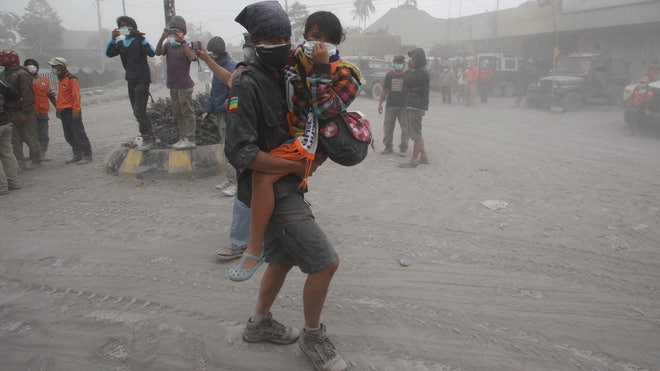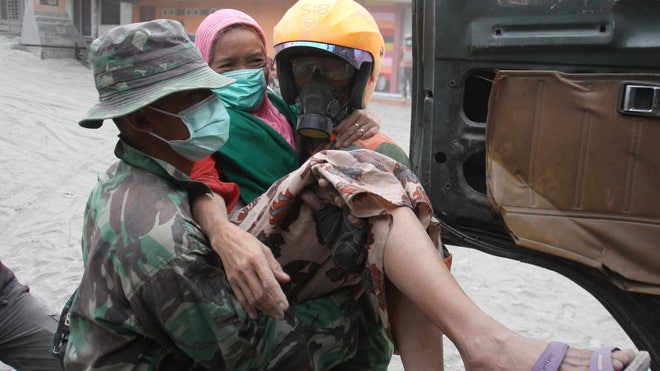Kepler habitable
Friday, February 28, 2014
Thursday, February 27, 2014
Monday, February 24, 2014
Sun-dimming volcanoes partly explain global warming hiatus-study | Reuters
BY ALISTER DOYLE, ENVIRONMENT CORRESPONDENT
OSLO Sun Feb 23, 2014 1:06pm EST
1 COMMENTS
- inShare2
- Share this
RELATED TOPICS
(Reuters) - Small volcanic eruptions help explain a hiatus in global warming this century by dimming sunlight and offsetting a rise in emissions of heat-trapping gases to record highs, a study showed on Sunday.
Eruptions of at least 17 volcanoes since 2000, including Nabro in Eritrea, Kasatochi in Alaska and Merapi in Indonesia, ejected sulfur whose sun-blocking effect had been largely ignored until now by climate scientists, it said.
The pace of rising world surface temperatures has slowed since an exceptionally warm 1998, heartening those who doubt that an urgent, trillion-dollar shift to renewable energies from fossil fuels is needed to counter global warming.
Explaining the hiatus could bolster support for a U.N. climate deal, due to be agreed by almost 200 governments at a summit in Paris in late 2015 to avert ever more floods, droughts, heatwaves and rising sea levels.
"This is a complex detective story," said Benjamin Santer of the Lawrence Livermore National Laboratory in California, lead author of the study in the journal Nature Geoscience that gives the most detailed account yet of the cooling impact of volcanoes.
"Volcanoes are part of the answer but there's no factor that is solely responsible for the hiatus," he told Reuters of the study by a team of U.S. and Canadian experts.
Volcanoes are a wild card for climate change - they cannot be predicted and big eruptions, most recently of Mount Pinatubo in the Philippines in 1991, can dim global sunshine for years.
Santer said other factors such as a decline in the sun's output, linked to a natural cycle of sunspots, or rising Chinese emissions of sun-blocking pollution could also help explain the recent slowdown in warming.
The study suggested that volcanoes accounted for up to 15 percent of the difference between predicted and observed warming this century. All things being equal, temperatures should rise because greenhouse gas emissions have hit repeated highs.
TEMPORARY RESPITE
"Volcanoes give us only a temporary respite from the relentless warming pressure of continued increases in carbon dioxide," said Piers Forster, Professor of Climate Change at the University of Leeds.
A study by the U.N. Intergovernmental Panel on Climate Change last year suggested that natural variations in the climate, such as an extra uptake of heat by the oceans, could help explain the warming slowdown at the planet's surface.
The IPCC projected a resumption of warming in coming years and said that "substantial and sustained" cuts in greenhouse gas emissions were needed to counter climate change.
It also raised the probability that human activities were the main cause of warming since 1950 to at least 95 percent from 90 in 2007. Despite the hiatus, temperatures have continued to rise - 13 of the 14 warmest years on record have been this century, according to the World Meteorological Organisation.
For the study, click on: dx.doi.org/10.1038/ngeo2098
Saturday, February 15, 2014
Indonesia Volcano Eruption 2014: Fleeing After Mount Kelud Erupts | The ...
----------------
Indonesian volcanic eruption brings life _ and cash _ as well as death and misery
Associated Press
 Soldiers and rescuers carry a woman to a truck for evacuation following an eruption of Mount Kelud, in Malang, East Java, Indonesia, Saturday, Feb. 15, 2014. The powerful volcanic eruption on Indonesia's most populous island blasted ash and debris 18 kilometers (12 miles) into the air Friday, forcing authorities to evacuate more than 100,000 and close seven airports. (AP Photo/Trisnadi) (THE ASSOCIATED PRESS)
Soldiers and rescuers carry a woman to a truck for evacuation following an eruption of Mount Kelud, in Malang, East Java, Indonesia, Saturday, Feb. 15, 2014. The powerful volcanic eruption on Indonesia's most populous island blasted ash and debris 18 kilometers (12 miles) into the air Friday, forcing authorities to evacuate more than 100,000 and close seven airports. (AP Photo/Trisnadi) (THE ASSOCIATED PRESS) A rescuer carries a child to a truck for evacuation following an eruption of Mount Kelud, in Malang, East Java, Indonesia, Saturday, Feb. 15, 2014. The powerful volcanic eruption on Indonesia's most populous island blasted ash and debris 18 kilometers (12 miles) into the air Friday, forcing authorities to evacuate more than 100,000 and close seven airports. (AP Photo/Trisnadi) (THE ASSOCIATED PRESS)
A rescuer carries a child to a truck for evacuation following an eruption of Mount Kelud, in Malang, East Java, Indonesia, Saturday, Feb. 15, 2014. The powerful volcanic eruption on Indonesia's most populous island blasted ash and debris 18 kilometers (12 miles) into the air Friday, forcing authorities to evacuate more than 100,000 and close seven airports. (AP Photo/Trisnadi) (THE ASSOCIATED PRESS) Soldiers and rescuers carry a woman to a truck for evacuation following an eruption of Mount Kelud, in Malang, East Java, Indonesia, Saturday, Feb. 15, 2014. The powerful volcanic eruption on Indonesia's most populous island blasted ash and debris 18 kilometers (12 miles) into the air Friday, forcing authorities to evacuate more than 100,000 and close seven airports. (AP Photo/Trisnadi) (THE ASSOCIATED PRESS)
Soldiers and rescuers carry a woman to a truck for evacuation following an eruption of Mount Kelud, in Malang, East Java, Indonesia, Saturday, Feb. 15, 2014. The powerful volcanic eruption on Indonesia's most populous island blasted ash and debris 18 kilometers (12 miles) into the air Friday, forcing authorities to evacuate more than 100,000 and close seven airports. (AP Photo/Trisnadi) (THE ASSOCIATED PRESS) Houses are covered with volcanic ash from an eruption of Mount Kelud in Malang, East Java, Indonesia, Saturday, Feb. 15, 2014. The powerful volcanic eruption on Indonesia's most populous island blasted ash and debris 18 kilometers (12 miles) into the air Friday, forcing authorities to evacuate more than 100,000 and close seven airports. (AP Photo/Trisnadi) (THE ASSOCIATED PRESS)
Houses are covered with volcanic ash from an eruption of Mount Kelud in Malang, East Java, Indonesia, Saturday, Feb. 15, 2014. The powerful volcanic eruption on Indonesia's most populous island blasted ash and debris 18 kilometers (12 miles) into the air Friday, forcing authorities to evacuate more than 100,000 and close seven airports. (AP Photo/Trisnadi) (THE ASSOCIATED PRESS) Vehicles and a street are covered with volcanic ash from an eruption of Mount Kelud in Malang, East Java, Indonesia, Saturday, Feb. 15, 2014. The powerful volcanic eruption on Indonesia's most populous island blasted ash and debris 18 kilometers (12 miles) into the air Friday, forcing authorities to evacuate more than 100,000 and close seven airports. (AP Photo/Trisnadi) (THE ASSOCIATED PRESS)
Vehicles and a street are covered with volcanic ash from an eruption of Mount Kelud in Malang, East Java, Indonesia, Saturday, Feb. 15, 2014. The powerful volcanic eruption on Indonesia's most populous island blasted ash and debris 18 kilometers (12 miles) into the air Friday, forcing authorities to evacuate more than 100,000 and close seven airports. (AP Photo/Trisnadi) (THE ASSOCIATED PRESS)
SIDOMULYO, INDONESIA – The ash and debris that Indonesia's Mount Kelud blasted from its belly brought death and misery, and disrupted international air traffic. But for many of the millions of people cleaning up Saturday in the wake of the explosive eruption, it was also a money earner and a shot of life for their crops.
"This is a blessing of the disaster," said Imam Choiri, a 55-year-old farmer who was scraping up the ash from the road to use as fertilizer on his small vegetable plot a few kilometers from the crater of the mountain, which was rumbling and smoking in the background. Choiri said locals believe the ash helps drive away pests from crops.
The eruption of the 1,731-meter (5,680-foot) -high mountain on Java island late Thursday was one of the most dramatic to hit Indonesia in recent years, with ash falling as far as 600 kilometers (370 miles) away. Three people were killed when their roofs caved in under the weight of ash, while around 100,000 fled.
On Saturday, scientists said Kelud's activities were dying down, in line with its reputation as a mountain that blows its top dramatically but then quickly settles down for another 10 years or so. But authorities warned that water from its crater, along with rain, could bring deadly landslides of fresh ash and rocks down river beds into villages and valleys.
Army troops enforced a ban on people returning to houses within 10 kilometers (6 miles) of the volcano, but many people sneaked back to check on livestock and clean up. Authorities were finding it hard to prevent people from returning, given the money farmers stand to lose by staying away.
"Our cows need to be milked. If they aren't, they can get sick and die," said Marjito, a 45-year-old man who was riding on a motorbike with his wife to his village around 5 kilometers (3 miles) from the crater.
"We have so much work to do, including running and hiding from security officers," said his wife, Dinayah. Like many Indonesians, both go by a single name.
Six airports on Java — Indonesia's most densely populated island and home to more than half of the country's 240 million people — remained closed, including the international hub that serves the country's second-largest city, Surabaya. Transport officials said this was because of ash on the runway and on planes, not in the atmosphere, and said the airports would likely reopen before Monday.
A massive cleanup was underway in the region, where millions of homes received ash fall. Police and soldiers used water cannons to clear roads that in places were covered in up to 10 centimeters (4 inches) of white ash. Supporters of political parties campaigning for April elections, wearing party colors, also chipped in and gave out food, seeking to win votes on the back of their assistance. Many people were wearing face masks to protect against the dust that remained in the air.
Kelud's last major eruption was in 1990, when it spewed out searing fumes and lava that killed more than 30 people and injured hundreds. In 1919, a powerful explosion that reportedly could be heard hundreds of kilometers away killed at least 5,160 people.
Indonesia, a sprawling archipelagic nation, is prone to volcanic eruptions and earthquakes because of its location on the Pacific "Ring of Fire" — a series of fault lines stretching from the Western Hemisphere through Japan and Southeast Asia.
Thirty-eight of the country's roughly 130 active volcanoes are on Java, forming a spine along the island's center. The regular dustings of the land volcanic eruptions bring help ensure soil fertility. Regular rain and sun mean rice, plants, coffee and fruit are easily cultivated.
Volcanic ash and debris are prized in the building industry because they make especially strong cement, and sand diggers can charge almost twice as much per load than they can for regular sand. Scores of diggers were collecting the fresh, easy-to-dig sand Saturday, packing the windfall into bags or onto trucks.
"Kelud is a valuable source of livelihood to me and my family," Harjito Huda, 30, a traditional sand miner from Ngancar village, said with a smile.
Extreme weather: the global situation
Wednesday, February 12, 2014
Thursday, February 6, 2014
Wednesday, February 5, 2014
Subscribe to:
Posts (Atom)
